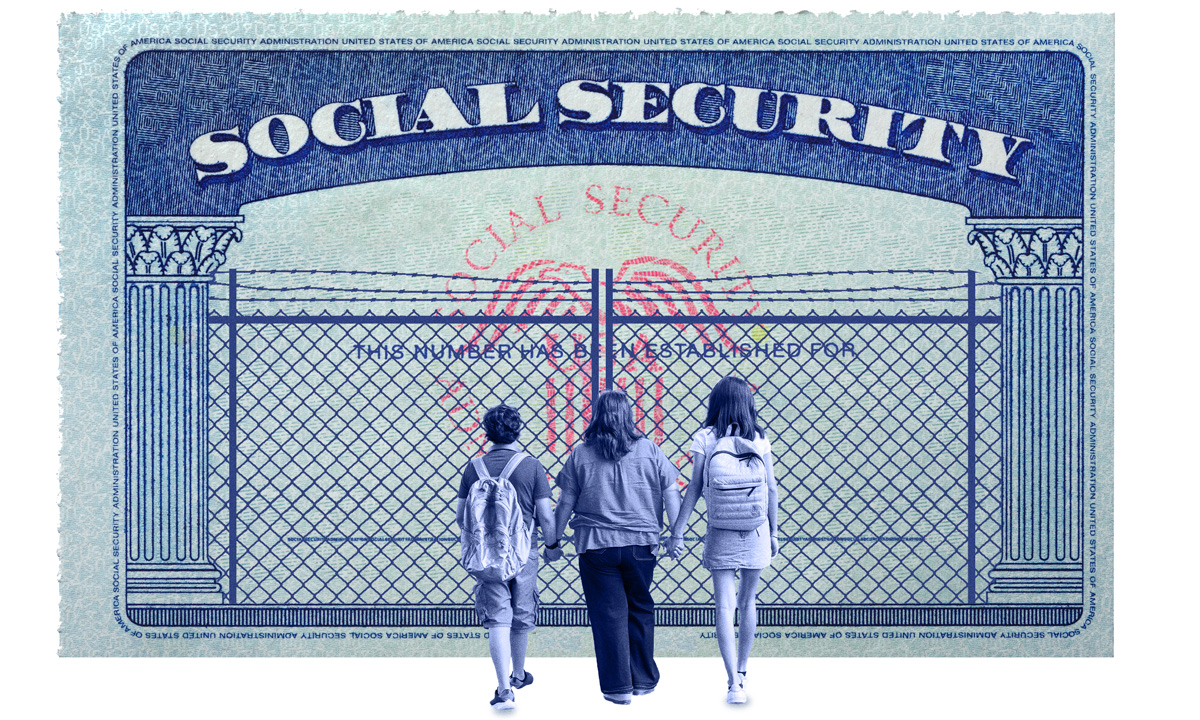Who Are the Kids and Families Left Out of the Updated Child Tax Credit?
A change to the Child Tax Credit requires children and at least one parent to have a Social Security Number. Here’s what that could mean for families.

Join our zero2eight Substack community for more discussion about the latest news in early care and education. Sign up now.
Cesilia Vega Gonzalez had one thought when she learned of the changes to the Child Tax Credit (CTC) under the reconciliation package that Congress passed this summer: They’re going after our kids again.
Gonzalez is a longtime community organizer and advocate who works with community health workers and in the local school system in Santa Ana, California, a city that has been hard hit by the ICE raids. Most kids and families she knows spent their summers cooped up inside for fear of walking outside and being taken. She has seen for herself kids running in search of safe places to go when they see a truck that could have ICE agents, and knows firsthand of parents being detained after walking kids to school, and of raids at a popular grocery store. “The aisles are now empty since no one ventures outside anymore,” she said.
But the changes to the tax code that target immigrant families are the least of her concerns right now. “We used to offer classes about how to pay taxes,” she said, speaking of The Promotoras, a community support group that she is involved in that provided resources for families adjusting to life in the United States. “But we aren’t even giving out information about the taxes now because we are so impacted by worrying about who is going to come home each night.
Growing up, as the granddaughter of Mexican immigrants, her grandfather would stop by the panaderia every Sunday and invite people who had recently arrived from Mexico into their house for menudo, a type of Mexican spicy stew. Gonzalez, fluent in both English and Spanish, would translate and help fill out immigration paperwork and tax forms.
For decades, immigrants in her community were actively encouraged to file taxes, she said. Having taxes in good standing was one of the criteria for gaining citizenship under the Reagan administration’s 1986 reform, which happened when Gonzalez was in 6th grade. But 40 years later, Gonzalez is now hearing from more people that they are scared to file taxes and have decided to hold off. “Who wants to tell the IRS where you are? Right now, silence is our safety.”
Changing the filing requirements for the Child Tax Credit is a recent action by the Trump administration to revoke benefits for noncitizens — one that creates a particular pain point for families with young children. In the reconciliation package passed this summer, Congress increased the CTC amount to $2,200 and indexed it to inflation, and also updated eligibility guidelines, including requiring children and at least one parent to have a Social Security number.
More than 5.6 million children who are American citizens are living with an undocumented immigrant according to estimates from a study published by Brookings Institution in April. More than 2.7 million are children in elementary and middle school grades and 1.96 million are under 6 years old.
Policy experts believe that many of these families would have qualified for the Child Tax Credit under the previous policy, but will no longer be able to receive it due to this change. Many of these kids are American citizens living with parents who pay taxes through an Individual Tax Identification Number (ITIN), not a Social Security number. The IRS issues ITINs and relies on them to collect tax revenue from people who may not have work authorization but still earn income in the United States. By contrast, a Social Security number is issued by the Social Security Administration and is only available to citizens and those legally authorized to work in the United States, including immigrants who are seeking asylum or have a pending asylum claim with work authorization.
A family’s income also plays a role. According to a policy brief from the Center on Poverty and Social Policy, an estimated 19 million children under age 17 will be ineligible for the full Child Tax Credit because their family’s income isn’t high enough to qualify, up from 17 million under the previous policy. For children under 6, estimates show that 30% could be ineligible for the full credit because of their family’s income. The analysis in the brief estimates that a family with two children will now need to make $41,500 in income to receive the full tax benefit, a leap from $36,000 under the previous policy.
Since its inception in 1997, the CTC has been a partially refundable tax credit, meaning that people who file with a little or no tax burden can still receive the credit in the form of a refund. And in 2021, it was the one time “advanced refundability” of the CTC that sent checks to so many households in America, cutting child poverty in half and being lauded as the most successful anti-poverty program in our country’s history (and no, the checks aren’t likely to return). The credit also enjoys widespread popularity with a 75% approval rating, which crosses party lines.
The shift to requiring that children and at least one parent have a Social Security number to access social benefits is part of a larger effort that dates back to the Gingrich era in 1996, explains Josh McCabe, director of social policy at the Niskanen Center. This was when Republicans took control of Congress and unveiled the “Contract for America,” which was designed to rework a number of the country’s social programs. This included changing the earned income tax credit — a refundable tax credit for low income families, which has been long considered one of the most effective anti-poverty programs — to require tax filers to have Social Security numbers. But even with the changes to the EITC, parents filing taxes with an ITIN could still claim the Child Tax Credit, McCabe explained.
Excluding immigrant families from receiving the CTC isn’t likely to have a meaningful impact on immigration, said McCabe. “Most people don’t migrate for tax credits,” he said. “But people who are here, legal or not, with families and with kids, will have fewer resources to get by on.”
Chris Wimer, director of the Center on Poverty and Social Policy and Megan Curran, policy director of the organization, said that while the changes brought about by this shift to the CTC will affect families, the impacts are dwarfed by the cuts to SNAP and Medicaid, which will hit families hard. Even the $200 increase in the CTC does little to offset it. “It’s basically lower than it was previously given that inflation has overtaken the $200 increase,” said Wimer.
“Those are the same kids that are going to see the cuts to SNAP and Medicaid and the ACA Tax Credits, and could see changes to eligibility for free school meals,” Curran said.
Economist Kathryn Edwards said that adding the additional Social Security number requirement is creating a “chilling effect.” She adds: “It is a very well documented phenomenon — when you target mixed status families they drop out of programs they are eligible for. These are kids eligible for Medicaid, but maybe the mom is afraid of what could happen to her brother. That is the point of all of these changes, intimidation and fear.”
For Gonzalez, there is little surprise that the CTC has been targeted. “They pick on the kids,” she said. “They know how much we love our families.” She works with many families that have at least one parent with an ITIN, and said many of them have been in this country for 20 years paying taxes. “They use their ITIN numbers to buy a house, get a phone or a car,” she said.
Any possible savings from limiting the CTC could be offset by those afraid of filing at all, she said. “The U.S. is going to be losing all that money.”
Get stories like these delivered straight to your inbox. Sign up for The 74 Newsletter


;)
